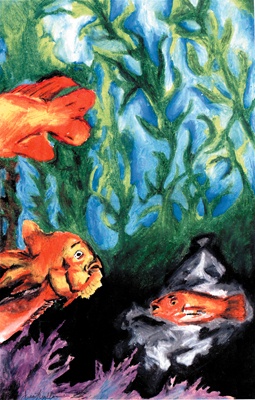All Nonfiction
- Bullying
- Books
- Academic
- Author Interviews
- Celebrity interviews
- College Articles
- College Essays
- Educator of the Year
- Heroes
- Interviews
- Memoir
- Personal Experience
- Sports
- Travel & Culture
All Opinions
- Bullying
- Current Events / Politics
- Discrimination
- Drugs / Alcohol / Smoking
- Entertainment / Celebrities
- Environment
- Love / Relationships
- Movies / Music / TV
- Pop Culture / Trends
- School / College
- Social Issues / Civics
- Spirituality / Religion
- Sports / Hobbies
All Hot Topics
- Bullying
- Community Service
- Environment
- Health
- Letters to the Editor
- Pride & Prejudice
- What Matters
- Back
Summer Guide
- Program Links
- Program Reviews
- Back
College Guide
- College Links
- College Reviews
- College Essays
- College Articles
- Back
Spongebob
“Who lives in a pineapple under the sea?”
No matter how bizarre the question may sound, just about anyone could answer it—SpongeBob SquarePants of course! Although the children’s television series seems like just the nautical adventures of a hilarious sea sponge and his friends, creator of SpongeBob SquarePants, Stephen Hillenburg, conceals a deeper satirical message in the personas of the seven main characters. Each marine creature in fact distinctly represents one of the Seven Deadly Sins. With the intended childhood audience, however, Hillenburg strategically hides the latent content by obscuring the series with jocular burlesque, achieved through various methods including irony and hyperbole. The very fact that Hillenburg can bring children to laugh about sins—or in other words, each character’s exaggerated hamartia—is why he is effective in his satire.
SpongeBob and his two neighbors, Patrick and Squidward, seem like simply an unlikely neighborhood trio, but Hillenburg strategically assigned each of them a sinful portrayal: lust, sloth, and wrath, respectively. Few see the connection between SpongeBob and lust, but it is quite easy to do so when considering lust as excessive affection. SpongeBob wakes up every morning loving life and everyone in Bikini Bottom, happily feeds his gluttonous snail Gary, and enthusiastically attends work (as a fry cook), which as we know, simply does not happen quite so joyfully in the real world. This clear burlesque of extreme optimism, or lust, contrasts severely with Squidward’s wrathful persona. Unlike SpongeBob, Squidward wakes up hating everything and everyone, except perhaps his beloved clarinet, which he ironically plays dreadfully. He does not only insult SpongeBob, but also his other neighbor, Patrick the sea star, to whom Hillenburg associated sloth. Patrick’s greatly exaggerated laziness is a hyperbole in itself and perfectly builds burlesque, especially in addition to the brilliantly dimwitted lines of his (“Is mayonnaise an instrument?”) that bring substantial humor into the show.
Aside from the main neighborhood, Hillenburg extends his satire to SpongeBob’s workplace, the Krusty Krab, owned by the exaggeratedly avaricious Mr. Krabs. One must not look very deep to realize that Mr. Krabs is the epitome of greed, once again exemplifying a hyperbole in the show. In one episode, he practically sacrifices his employees in order to retrieve his “lucky dollar bill.” With every business, however, comes a rival—and for the Krusty Krab, this rival is Plankton’s Chum Bucket. The Krusty Krab clearly dominates the industry though, which is the source of Plankton’s undying envy. Unfortunately for Plankton, all of his elaborate evil schemes to steal the Krusty Krab’s secret recipe ironically backfire in the end, leaving him squashed. Probably the most ridiculous burlesque of the entire series, however, is achieved through Sandy Cheeks, the squirrel from Texas who lives underwater and obviously does not have a problem gushing pride of her hometown.
Stephen Hillenburg succeeds on two levels in his famous series SpongeBob SquarePants. While he is the creator of one of the most popular children’s television shows, he is also a master of disguise. The overwhelming burlesque of the series, achieved through methods such as irony and hyperbole, camouflages any hints of seriousness implied by Hillenburg’s incorporation of the Seven Deadly Sins. Bikini Bottom reeks of satire, yet as Hillenburg intends, children cannot see past the burlesque, laughing at the embellished sinful portrayals rather than fearing them.

Similar Articles
JOIN THE DISCUSSION
This article has 0 comments.
